学生英语能力自评╱互评表
- 格式:doc
- 大小:132.50 KB
- 文档页数:8
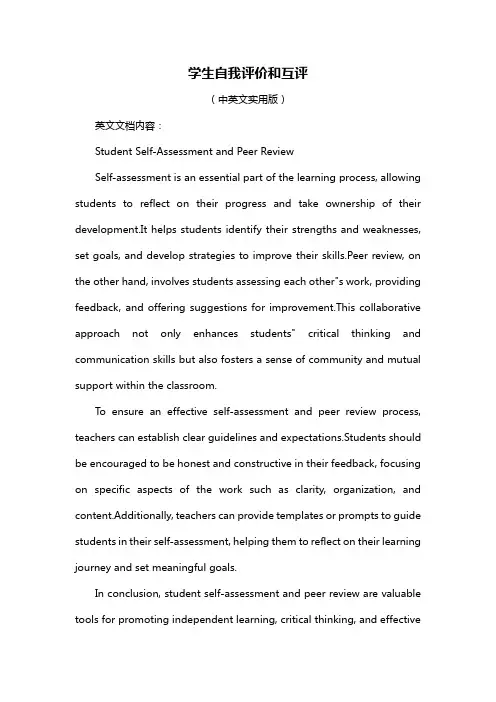
学生自我评价和互评(中英文实用版)英文文档内容:Student Self-Assessment and Peer ReviewSelf-assessment is an essential part of the learning process, allowing students to reflect on their progress and take ownership of their development.It helps students identify their strengths and weaknesses, set goals, and develop strategies to improve their skills.Peer review, on the other hand, involves students assessing each other"s work, providing feedback, and offering suggestions for improvement.This collaborative approach not only enhances students" critical thinking and communication skills but also fosters a sense of community and mutual support within the classroom.To ensure an effective self-assessment and peer review process, teachers can establish clear guidelines and expectations.Students should be encouraged to be honest and constructive in their feedback, focusing on specific aspects of the work such as clarity, organization, and content.Additionally, teachers can provide templates or prompts to guide students in their self-assessment, helping them to reflect on their learning journey and set meaningful goals.In conclusion, student self-assessment and peer review are valuable tools for promoting independent learning, critical thinking, and effectivecommunication.By integrating these practices into the classroom, educators can create a supportive and engaging learning environment that empowers students to take control of their own growth and development.中文文档内容:学生自我评价与互评自我评价是学习过程中的重要环节,使学生能够反思自己的进步并承担起自身发展的责任。
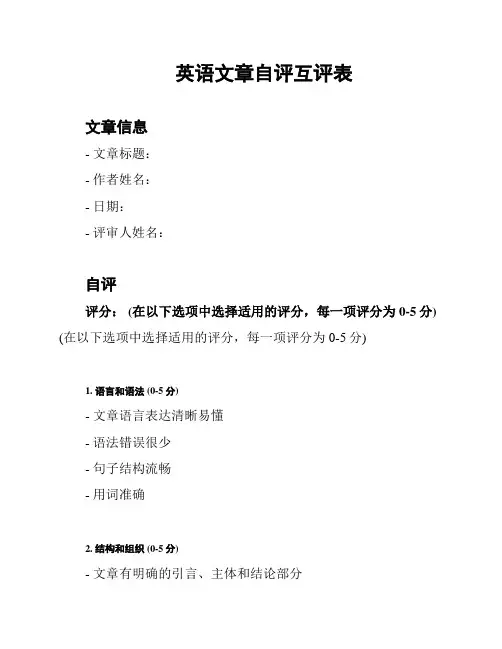
英语文章自评互评表文章信息- 文章标题:- 作者姓名:- 日期:- 评审人姓名:自评评分: (在以下选项中选择适用的评分,每一项评分为0-5分) (在以下选项中选择适用的评分,每一项评分为0-5分)1. 语言和语法 (0-5分)- 文章语言表达清晰易懂- 语法错误很少- 句子结构流畅- 用词准确2. 结构和组织 (0-5分)- 文章有明确的引言、主体和结论部分- 每个段落都有明确的主题句- 段落之间过渡自然3. 内容与观点 (0-5分)- 文章内容准确、全面- 观点清晰明确- 有足够的证据和支持材料4. 描述和解释 (0-5分)- 描述准确生动- 解释清晰易懂- 用例子或论证来支持描述和解释5. 结论 (0-5分)- 结论简洁明确- 呼应引言并总结主要观点- 提供展望或启示6. 文章整体印象 (0-5分)- 文章给人留下深刻印象- 文章读起来有趣- 文章吸引读者继续阅读的兴趣互评评分: (在以下选项中选择适用的评分,每一项评分为0-5分) (在以下选项中选择适用的评分,每一项评分为0-5分)1. 语言和语法 (0-5分)- 文章语言表达清晰易懂- 语法错误很少- 句子结构流畅- 用词准确2. 结构和组织 (0-5分)- 文章有明确的引言、主体和结论部分- 每个段落都有明确的主题句- 段落之间过渡自然3. 内容与观点 (0-5分)- 文章内容准确、全面- 观点清晰明确- 有足够的证据和支持材料4. 描述和解释 (0-5分)- 描述准确生动- 解释清晰易懂- 用例子或论证来支持描述和解释5. 结论 (0-5分)- 结论简洁明确- 呼应引言并总结主要观点- 提供展望或启示6. 文章整体印象 (0-5分)- 文章给人留下深刻印象- 文章读起来有趣- 文章吸引读者继续阅读的兴趣总结请根据以上问题的评分汇总,向作者提出您的建议和改进建议。
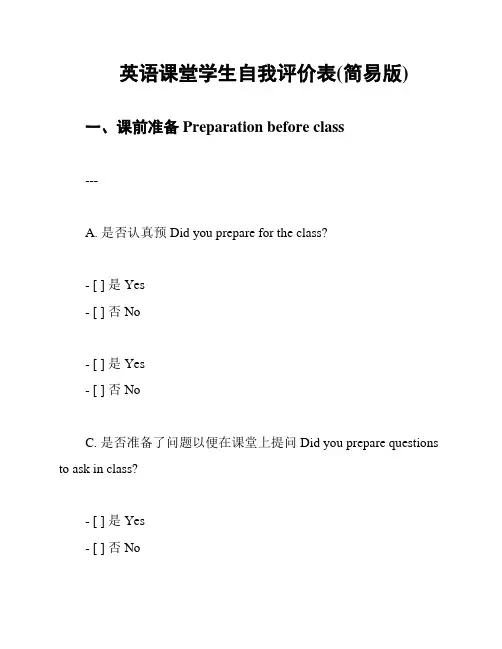
英语课堂学生自我评价表(简易版)一、课前准备 Preparation before class---A. 是否认真预 Did you prepare for the class?- [ ] 是 Yes- [ ] 否 No- [ ] 是 Yes- [ ] 否 NoC. 是否准备了问题以便在课堂上提问 Did you prepare questions to ask in class?- [ ] 是 Yes- [ ] 否 No---二、参与度 Participation---A. 是否积极回答问题 Did you actively participate in answering questions?- [ ] 是 Yes- [ ] 否 No- [ ] 是 Yes- [ ] 否 NoC. 是否与教师保持良好的互动 Did you engage in a positive interaction with the teacher?- [ ] 是 Yes- [ ] 否 No---三、听说读写 Skills in Listening, Speaking, Reading, and Writing---A. 听力 Listening- [ ] 较好 Good- [ ] 一般 Average- [ ] 需改进 Needs improvementB. 口语 Speaking- [ ] 较好 Good- [ ] 一般 Average- [ ] 需改进 Needs improvementC. 阅读 Reading- [ ] 较好 Good- [ ] 一般 Average- [ ] 需改进 Needs improvementD. 写作 Writing- [ ] 较好 Good- [ ] 一般 Average- [ ] 需改进 Needs improvement---四、自我评价 Self-evaluation请在下方简要写下你对自己在本学期的英语研究方面的评价,并提出自己未来进步的目标。
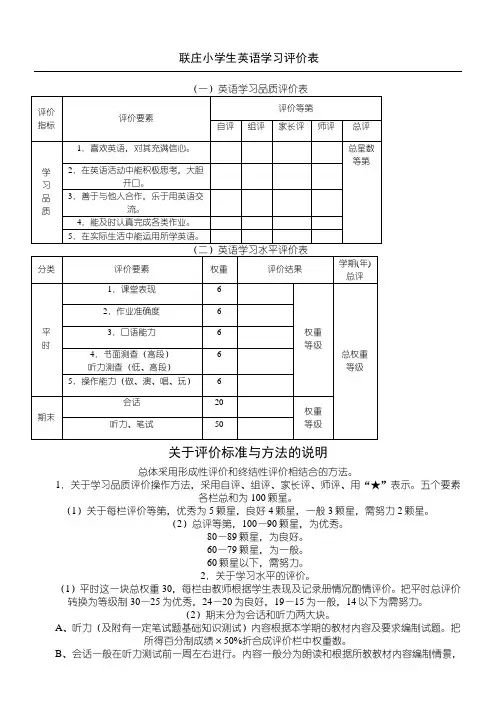
联庄小学生英语学习评价表
关于评价标准与方法的说明
总体采用形成性评价和终结性评价相结合的方法。
1.关于学习品质评价操作方法,采用自评、组评、家长评、师评、用“★”表示。
五个要素
各栏总和为100颗星。
(1)关于每栏评价等第,优秀为5颗星,良好4颗星,一般3颗星,需努力2颗星。
(2)总评等第,100—90颗星,为优秀。
80—89颗星,为良好。
60—79颗星,为一般。
60颗星以下,需努力。
2.关于学习水平的评价。
(1)平时这一块总权重30,每栏由教师根据学生表现及记录册情况酌情评价。
把平时总评价转换为等级制30—25为优秀,24—20为良好,19—15为一般,14以下为需努力。
(2)期末分为会话和听力两大块。
A、听力(及附有一定笔试题基础知识测试)内容根据本学期的教材内容及要求编制试题。
把
所得百分制成绩×50%折合成评价栏中权重数。
B、会话一般在听力测试前一周左右进行。
内容一般分为朗读和根据所教教材内容编制情景,
对话表演为主。
每一学期会话测试具体内容形式及评分标准由区中心备课小组统一命题,情景对话准备内容提前5天发给学生,全区统一时间测试。
具体组织操作由各校自定。
教师根据测试结果给予权重分数,最高为20。
然后把会话和听力的权重数相加得出期末评价等第,70—63为优秀,62—56为良好,
55—42为一般,41以下为需努力。
学期(年)总评就是把平时和期末的权重指数相加得出总数,再转化成等级数。
标准等同于学
习品质栏中。
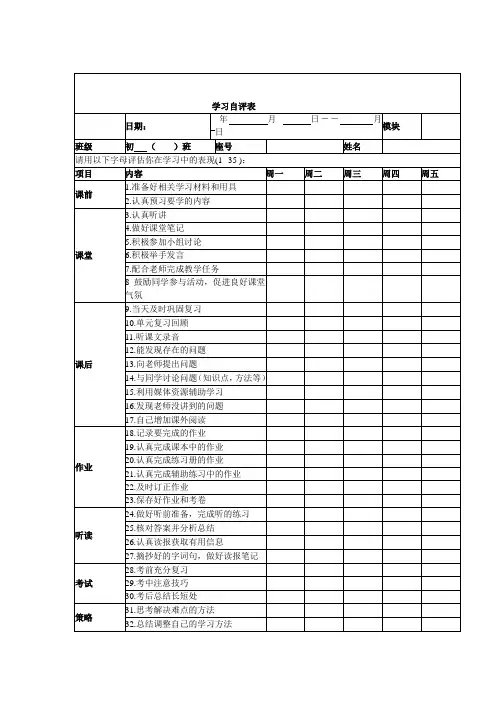
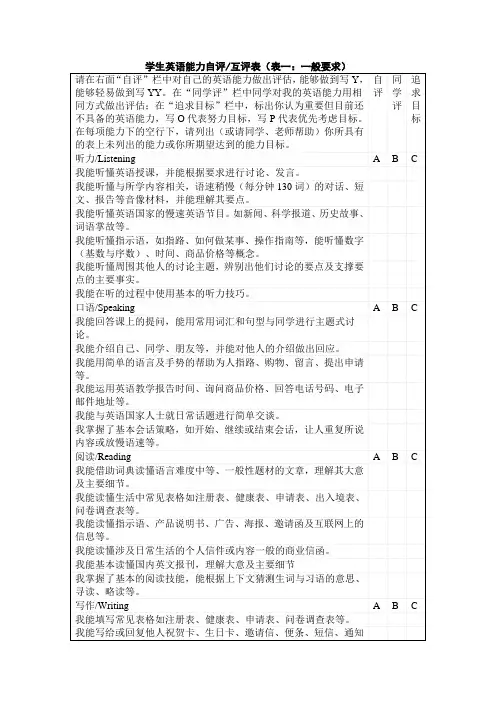
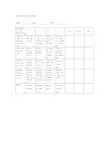
英语作文自评互评表:
班级:姓名:学号:
评论级别
A B C D自评小组评师评参照标准
字体能否字体工整,字体基本字体欠工字体潦草,
工整,拼写拼写正确,工整,有少整,有涂改有多处涂
能否正确,作业整齐许错误,作现象,文中改,好多错
作业能否业基本整有一些错误,字数不
洁净洁误够
语法、词汇应用了较能应用一语法构造文章语法
运用能否多的语法些语法结单一、词汇错误许多,
正确构造和高构和词汇项目有限,词汇很有
级词汇不影响理限,影响理
解解
内容能否重点齐备,重点基本重点基本重点不全,
内容完好,齐备,内容齐备,内容
完好,重点
内容过于
能否齐备看法不明较完好,有较完好,内
确意义容一般简单
文章逻辑有效地使应用简单较少使用语句断短
性能否强,用了语句的语句间语句间的续续,行文
连结能否间的连结的连结成连结成分,不流利,无
成分,使全分,使全文内容缺乏连词过分
紧凑
文构造紧构造紧凑连结性
凑
创建性有创建性,较有创建创意不够,没有创意,
表现力强性,简要,较完好内容不完
完好整。
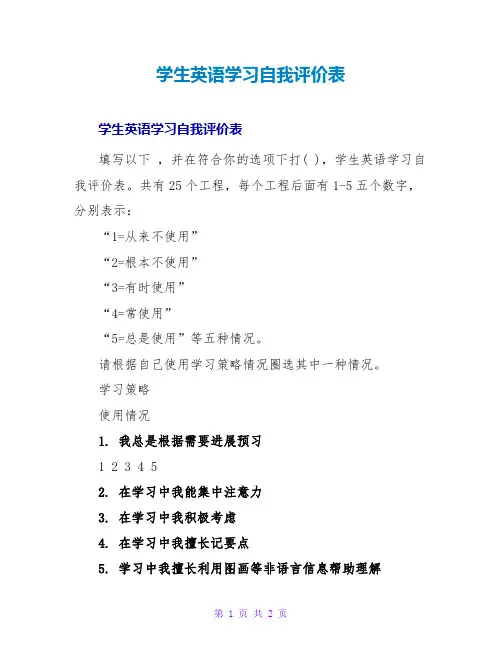
学生英语学习自我评价表
学生英语学习自我评价表
填写以下,并在符合你的选项下打( ),学生英语学习自我评价表。
共有25个工程,每个工程后面有1-5五个数字,分别表示:
“1=从来不使用”
“2=根本不使用”
“3=有时使用”
“4=常使用”
“5=总是使用”等五种情况。
请根据自己使用学习策略情况圈选其中一种情况。
学习策略
使用情况
1. 我总是根据需要进展预习
1 2 3 4 5
2. 在学习中我能集中注意力
3. 在学习中我积极考虑
4. 在学习中我擅长记要点
5. 学习中我擅长利用图画等非语言信息帮助理解
6. 我通常借助联想学习和记忆词语
7. 我对所学内容主动复习并加以整理和归纳
8. 我注意发现语言的'规律并运用规律举一反三
9. 使用英语时我能意识到错误并适当纠正
10. 必要时我借助汉语知识理解英语
11. 我经常阅读英语故事及其他英语课外读物
12. 我借助联想把相关知识联络起来
13. 我经常利用推理、归纳等手段分析^p 和解决问题
14. 我有明确的英语学习目的
15. 我经常制定英语学习方案
16. 我积极探究合适自己的英语学习方法
17. 我经常与教师和同学交流学习体会
18. 我尽量通过多种渠道学习英语
19. 我对英语和英语学习有积极的态度
20. 我逐步树立学习英语的信心
21. 在交际中,我经常借助手势、表情等进展表达
22. 在交际中我注意中外交际风俗的差异
23. 在交际中,我能克制语言障碍,维持交际
24. 我注意通过音像资料丰富自己的学习
25. 我经常使用工具书查找信息。
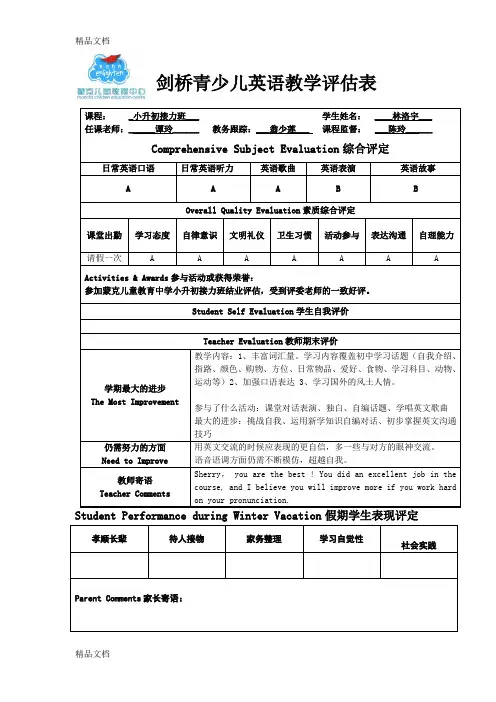
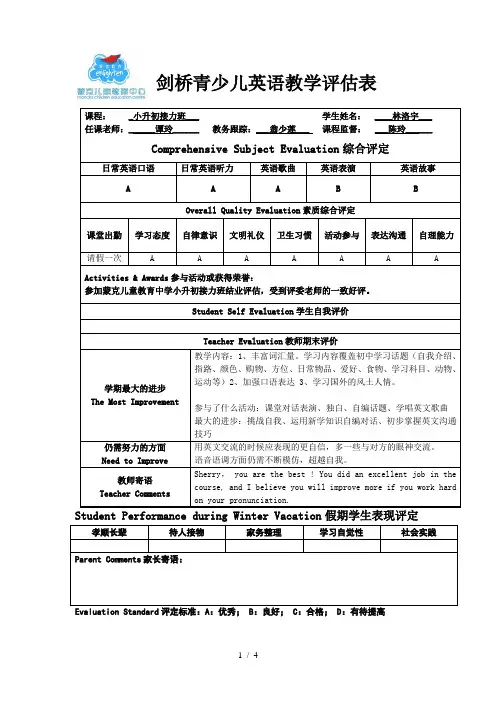
剑桥青少儿英语教学评估表Student Performance during Winter Vacation 假期学生表现评定孝顺长辈待人接物家务整理学习自觉性社会实践Parent Comments 家长寄语:Evaluation Standard 评定标准:A :优秀; B :良好; C :合格; D :有待提高课程: _小升初接力班___ 学生姓名: ____林洛宇___ 任课老师:______谭玲______ 教务跟踪:___翁少莲___ 课程监督: ___陈玲______Comprehensive Subject Evaluation 综合评定日常英语口语日常英语听力英语歌曲英语表演英语故事AAABBOverall Quality Evaluation 素质综合评定课堂出勤 学习态度 自律意识 文明礼仪 卫生习惯 活动参与 表达沟通 自理能力 请假一次AAAAAAAActivities & Awards 参与活动或获得荣誉:参加蒙克儿童教育中学小升初接力班结业评估,受到评委老师的一致好评。
Student Self Evaluation 学生自我评价Teacher Evaluation 教师期末评价学期最大的进步 The Most Improvement教学内容:1、丰富词汇量。
学习内容覆盖初中学习话题(自我介绍、指路、颜色、购物、方位、日常物品、爱好、食物、学习科目、动物、运动等)2、加强口语表达 3、学习国外的风土人情。
参与了什么活动:课堂对话表演、独白、自编话题、学唱英文歌曲 最大的进步:挑战自我、运用新学知识自编对话、初步掌握英文沟通技巧仍需努力的方面 Need to Improve 用英文交流的时候应表现的更自信,多一些与对方的眼神交流。
语音语调方面仍需不断模仿,超越自我。
教师寄语Teacher CommentsSherry , you are the best ! You did an excellent job in the course, and I believe you will improve more if you work hard on your pronunciation.孝顺长辈待人接物家务整理学习自觉性社会实践Parent Comments 家长寄语:Evaluation Standard 评定标准:A :优秀; B :良好; C :合格; D :有待提高课程: __小升初接力班___ 学生姓名: ___雷桐_______ 任课老师:______谭玲______ 教务跟踪:___翁少莲___ 课程监督:___陈玲_______Comprehensive Subject Evaluation 综合评定日常英语口语日常英语听力英语歌曲英语表演英语故事AABBBOverall Quality Evaluation 素质综合评定课堂出勤 学习态度 自律意识 文明礼仪 卫生习惯 活动参与 表达沟通 自理能力 全勤AAAAAAAActivities & Awards 参与活动或获得荣誉:参加蒙克儿童教育中学小升初接力班结业评估,受到评委老师的一致好评。
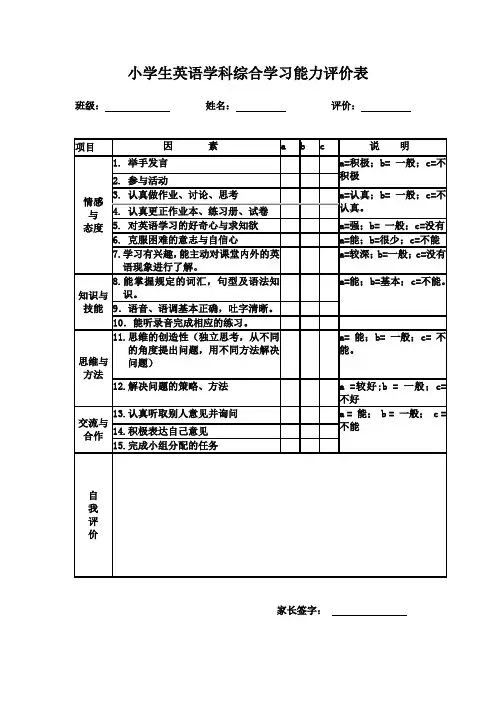
英语课自我评价量表英文回答:I believe that I am a hard-working and dedicated English student. I always complete my homework on time and I am always prepared for class. I am also an active participant in class discussions and I am always willing to help my classmates.I am confident in my ability to read, write, and speak English. I can understand complex texts and I can write essays that are clear and well-organized. I can also communicate effectively in English in both formal and informal settings.I am eager to learn more about English and I am always looking for ways to improve my skills. I am currently taking an English literature course and I am enjoying learning about the works of some of the great English writers. I am also planning to take an English grammarcourse in the future.I believe that my English skills will be valuable to me in my future career. I plan to work in a field that requires strong communication skills and I am confidentthat my English skills will help me to succeed.I have a few areas that I would like to improve in my English skills. I would like to improve my vocabulary and my pronunciation. I would also like to be able to write more fluently. I am confident that I can improve these areas with practice and I am committed to doing so.Overall, I believe that I am a strong English student with a solid foundation in the language. I am eager to continue learning and improving my skills. I am confident that I will be successful in my future career and I believe that my English skills will be a valuable asset to me.中文回答:我认为自己是一位勤奋且专心的英语学生。
初中英语学生自我评价表Here is an essay on the topic of "Self-Evaluation Form for Middle School English Students" with more than 1000 words, written in English without any extra punctuation marks in the body of the text.Learning a new language can be a challenging yet rewarding experience for any student. As a middle school English student, it is important to regularly assess one's progress and identify areas for improvement. A self-evaluation form can be a valuable tool in this process, allowing students to reflect on their strengths, weaknesses, and overall language proficiency.One of the key components of the self-evaluation form is the assessment of listening comprehension skills. Being able to understand spoken English is crucial for effective communication and academic success. Students should evaluate their ability to follow instructions, comprehend conversations on familiar topics, and identify key information in audio recordings. This can be done by reflecting on classroom experiences, as well as any exposure to English-language media, such as movies, TV shows, or podcasts.Another important aspect is the evaluation of speaking skills.Students should consider their confidence in expressing themselves in English, their ability to engage in basic conversations, and their pronunciation accuracy. This can be assessed through role-play activities, presentations, or even informal conversations with the teacher or classmates. It is important for students to identify any areas of difficulty, such as grammar usage, vocabulary limitations, or hesitancy in speech, and to develop strategies to improve these skills.Reading comprehension is also a crucial component of language learning. The self-evaluation form should prompt students to assess their ability to understand written texts, such as short stories, articles, or textbook passages. This can involve evaluating their skills in identifying main ideas, understanding vocabulary in context, and drawing inferences from the text. Students should also consider their reading speed and fluency, as well as their ability to apply reading strategies, such as skimming, scanning, or close reading.Writing skills are another essential aspect of language proficiency. The self-evaluation form should encourage students to reflect on their ability to express themselves in written English, including their mastery of grammar, sentence structure, and vocabulary. Students should also consider their skills in organizing their thoughts, developing coherent paragraphs, and effectively communicating their ideas. Additionally, they should evaluate their ability to revise and edit their work, as this is a crucial step in the writing process.In addition to the core language skills, the self-evaluation form should also address students' understanding of cultural aspects related to the English-speaking world. This can include their knowledge of cultural customs, traditions, and social norms, as well as their ability to navigate cross-cultural situations and communicate effectively with people from diverse backgrounds.Another important component of the self-evaluation form is the assessment of learning strategies and study habits. Students should reflect on their ability to set achievable goals, manage their time effectively, and utilize various learning resources, such as dictionaries, grammar guides, or online tools. This can help them identify areas where they need to improve their study skills and develop more effective learning strategies.Finally, the self-evaluation form should encourage students to set personal goals and action plans for improvement. By identifying their strengths and weaknesses, students can develop a clear understanding of their current language proficiency and create a roadmap for future growth. This can involve setting specific, measurable, and attainable goals, as well as outlining the steps they will take to achieve these goals, such as seeking additional practice opportunities, attending tutoring sessions, or engaging in self-directed learning activities.In conclusion, the self-evaluation form for middle school English students is a valuable tool that can help students take an active role in their language learning journey. By regularly assessing their progress, identifying areas for improvement, and setting personalized goals, students can develop a deeper understanding of their language skills and take ownership of their learning process. This, in turn, can lead to greater academic success, improved communication abilities, and a stronger foundation for future language learning.。
附2:
学生英语能力自评/互评表
使用说明
1.《学生英语能力自评/互评表》细化和列举了一般要求、较高要求和更高要求中的各项语言技能,可以帮助教师更好地理解不同层次的教学要求,在教学中增强针对性。
教师还可以根据本校的大学英语教学大纲,补充或调整有关的微技能。
2.在教学开始时,教师向学生介绍自评/互评表中各项微技能,帮助学生了解教学要求。
3.教师定期要求学生进行自评和互评,通过评估,帮助学生了解自己对语言微技能的掌握情况,及时调整学习行为。
4.学生在自评/互评表右面的“评价”栏中对自己或同学的英语能力做出评估,能够做到的打钩()。
根据自评或互评的结果,参考下表中的提示,对下一阶段的学习作出相应安排。
优良中差
能掌握各项语言技能中所有的微技能;完全达到本层次的教学要求。
能掌握各项语言技
能中3/4左右的微
技能;较好地达到
本层次的教学要
求,稍加努力,可
望实现学习目标。
能掌握各项语言技
能中2/3左右的微
技能;基本达到本
层次的教学要求,
但仍应继续努力。
未能掌握各项语言
技能中1/2的微技
能;未达到本层次
的教学要求,应寻
求指导,调整学习
方法和计划。
自评和互评结果记录可以参考下表:
日期(年/月/日)
评估方式
()
评估结果(优、良、中、差)
自评互评听说读写译
3
表1:一般要求评
价听力/Listening
我能听懂英语授课,并能根据要求进行讨论、发言。
我能听懂与所学内容相关、语速稍慢(每分钟130-150词)的对话、短文、报告等音
像材料,并能理解其要点。
我能听懂慢速英语节目,如新闻、科学报导、历史故事等。
我能听懂指示语,如指路、如何做某事、操作指南等,能听懂数字(基数与序数)、
时间等。
我能听懂讨论的主题,能掌握其中心大意,抓住要点。
我能在听的过程中使用基本的听力技巧。
口语/Speaking
我能回答课上的提问,能用常用词汇和句型与同学进行讨论,能就所熟悉的话题经
准备后作简短发言。
我能介绍自己、同学、朋友等,并能对他人的介绍做出回应。
我能用简单的语言为人指路、购物、留言、提出请求等。
我能运用英语数字报告时间、询问商品价格、回答电话号码、电子邮件地址等。
我能与英语国家人士就日常话题进行简单交谈。
我掌握了基本会话策略,如开始、继续或结束会话,让人重复所说内容等。
阅读/Reading
我能以中等速度(每分钟70词)基本读懂语言难度中等、一般性题材的文章,理解
其大意及主要细节。
我能以较快速度(每分钟100词)阅读篇幅较长、语言难度略低的文章。
我能借助词典阅读本专业的英语教材和题材熟悉的英文报刊的文章,掌握中心大意,
理解主要事实和有关细节。
我能读懂生活中常见表格如注册表、申请表、问卷调查表等。
我能读懂指示语、产品说明书、广告、海报、邀请函等。
我能读懂涉及日常生活的个人信件或内容一般的商业信函。
我能浏览互联网上的一般信息,基本读懂国内英文报刊,理解大意及主要事实。
我掌握了基本的阅读技能,如根据上下文猜测生词或习语的意思、寻读、略读等。
4
写作/Writing
我能填写常见表格如注册表、申请表、问卷调查表等。
我能写给或回复他人祝贺卡、生日卡、邀请信、便条、短信、通知等。
我能写出简单的指示语、个人广告、社团海报、个人简历等。
我能简要地描述个人经历、发生的事件、读过的故事、观看的影片、喜怒哀乐等情感,写出或回答个人或公司的信函、电子邮件、传真等。
我能就一定话题或提纲在30分钟内写出不少于120词的短文,内容基本完整、中心思想明确、用词恰当、语意连贯。
我能在一般写作或应用文写作中恰当使用相应的写作技能。
翻译/Translating
我能借助词典对题材熟悉的文章进行英译汉,译速为每小时约300个英语单词,译文基本传达原文的意义,无重大的理解和语言错误,符合中文表达习惯。
我能借助词典对题材熟悉的文章进行汉译英,译速为每小时约250个汉字,译文基本传达原文的意义,无重大的理解和语言错误,符合英文表达习惯。
我能借助词典对与专业相关的文章、介绍、提要、广告、产品说明书等翻译成汉语。
我能使用基本的翻译技巧。
5
表2:较高要求评
价听力/Listening
我能听懂英语谈话或讲座,能理解要点和细节。
我能听懂题材熟悉、篇幅较长的英语广播或电视节目,语速为每分钟150-180词左右,
如新闻报道、访谈、讲座等,并能理解其大意及主要细节。
我能基本听懂用英语讲授的专业课程。
我能使用基本的听力技巧帮助理解,如听要点或细节的方法。
口语/Speaking
我能就熟悉的话题与英语国家人士进行较为流利的会话,能将会话或讨论进行下去,
并能接受或礼貌地拒绝对方的意见。
我能根据地图或指示册等用较复杂的语言为人指方向、说明情况、解释疑难问题等。
我能基本表达个人的情感,如惊异、好恶、沮丧、抱怨等,能表达个人就某一事件
的观点和意见。
我能基本完整地讲述一个故事,如故事的发生、发展、结局,时间、地点、人物、
原因等。
我能基本描述个人经历、体验,如发生过或经历过的一件事情,表达愿望与理想,
如旅行计划或理想的职业等。
阅读/Reading
我能以中等速度(每分钟70-90词)基本读懂英语国家大众性报刊杂志上一般性题材
的文章。
我能以较快速度(每分钟120词)阅读篇幅较长、难度适中的文章。
我能略读新闻、人物、事件等报导的主要内容,抓住其要点,能寻读有关材料,快
速查找所需信息。
我能阅读所学专业的综述性文献,并能正确理解中心大意,抓住主要事实和有关细
节。
我能借助词典读懂与我专业相关的技术性论文,能从技术性手册中快速查找所需信
息以解决遇到的技术问题。
写作/Writing
我能就所读一般主题的文章写出其摘要或大纲,能阐述自己对某一焦点问题的观点,
并能基本陈述赞成或反对的理由。
我能写所学专业论文的英文摘要。
6
我能写出日常的应用文章,结构与表达符合应用文体规范。
我能借助参考资料写出专业小论文,结构基本清晰。
我能就一般性主题在半小时内写出不少于160词的记叙文、说明文或议论文,内容完整,观点明确、条理清楚、文理通顺。
翻译/Translating
我能借助词典翻译英语国家一般报刊上题材熟悉的文章。
英汉译速为每小时约350个英语单词,译文通顺达意,理解和语言表达错误较少。
我能借助词典对一般性题材的文章进行汉译英,译速为每小时约300个汉字,译文通顺达意,理解和语言表达错误较少。
我能摘译所学专业的英语文献资料。
译文符合中文表达习惯。
我能使用适当的翻译技巧。
7
表3:更高要求评
价听力/Listening
我能听懂语速正常、内容稍长的对话、短文、报告等,并在其结构复杂、观点较为
隐含时也能理解其要点和主要细节。
我能基本听懂语速正常的英语国家广播及电视节目,如新闻报道、访谈、讲座、电
影、电视剧等,并能掌握中心思想,抓住要点。
我能听懂用英语讲授的专业课程和英语讲座。
我能听懂涉及专业知识的学术报告、专题讲座等,并能理解其中阐述的事实或包含
的较为抽象的概念。
口语/Speaking
我能就一般或专业性话题较为流利、准确地与英语国家人士对话或讨论,并能将对
话或讨论有效地进行下去。
我能就个人目的或社会交际目的灵活、有效地使用英语表达自己的意念,如情感表
达、意愿表达等。
我能用简要的语言概括较长、语言稍难的文章或讲话,并能对某一题目给出较长的
解释和说明。
我能在学术会议或专业交流中较为自如地表达自己的观点和看法,重点突出、内容
完整、语言流畅。
我能使用较高的讲话技巧,如引起听众的注意力、维持听众热情、协调与其他讲话
人的关系等。
阅读/Reading
我能读懂有一定难度的文章,理解其主旨大意及细节。
我能借助词典读懂原版英语教材和英语国家报刊杂志上的文章。
我能较为顺利地阅读所学专业的英语文献和资料。
写作/Writing
我能就一般性主题比较自如地表达个人的观点,做到文章结构清晰、内容丰富、逻
辑性强。
我能将从不同渠道获取的信息进行归纳、总结,写成英文概要或汇报提纲。
我能撰写专业文章摘要,能写简短的专业报告和论文。
我能就一般性主题在半小时内写出不少于200词的记叙文、说明文或议论文,思想
表达清楚、文章结构清晰、内容丰富、逻辑性强。
8
翻译/Translating
我能借助词典翻译所学专业的文献资料和英语国家报刊上有一定难度的科普、文化、评论等文章,英汉译速为每小时约400个英语单词,理解准确,基本无错译、漏译,译文流畅。
我能将反映中国国情或文化的介绍性的文章译为英文,汉英译速为每小时约350个汉字,基本无错译、漏译,译文达意,符合英语表达习惯。
9
10。